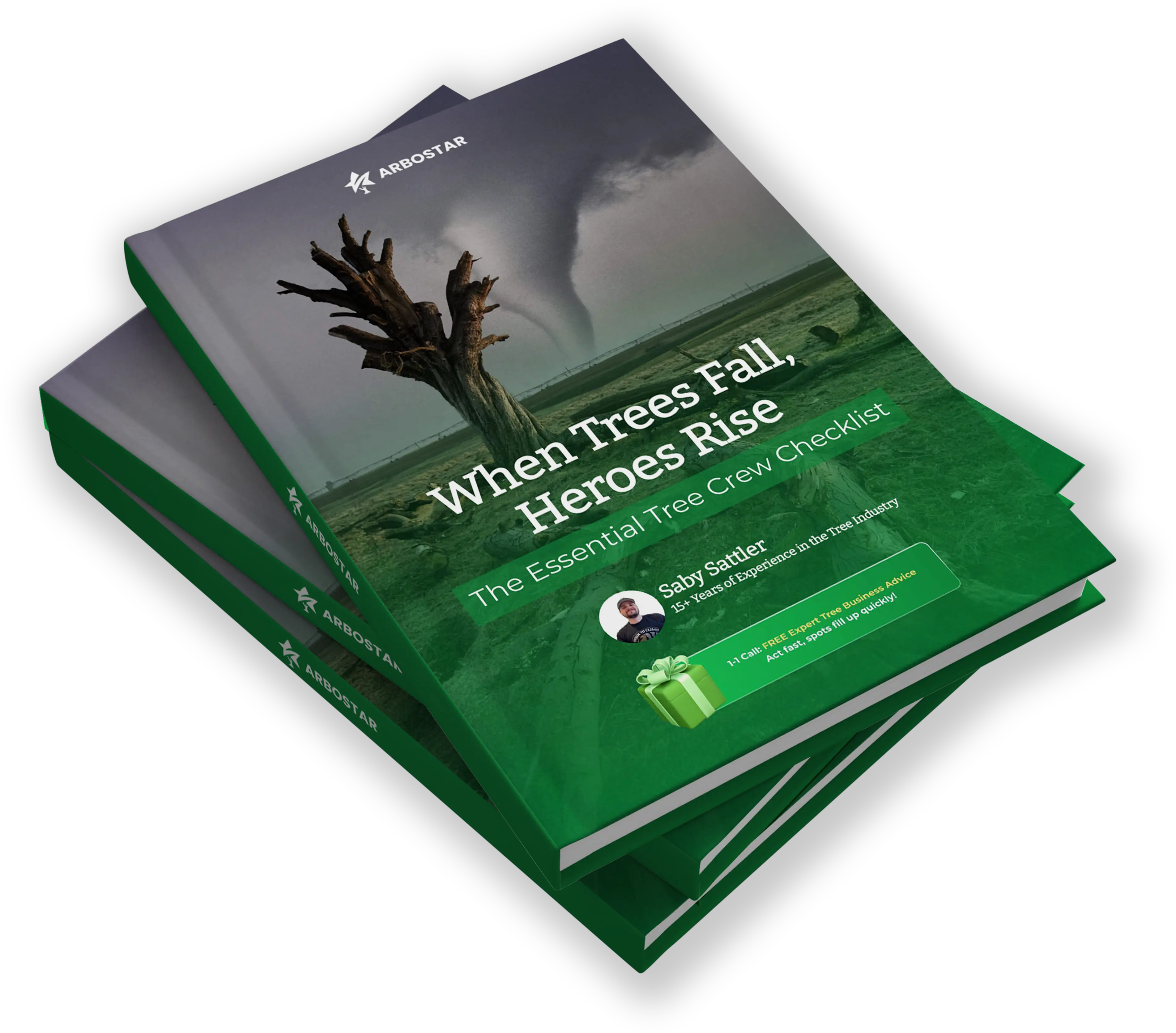Tree Service Insurance Requirements in 2025

Why Tree Service Insurance Matters for Your Business
Operating a tree service business in today's landscape extends far beyond mastering chainsaws and operating cranes, it fundamentally revolves around managing substantial liability exposure. A single mishap involving a falling branch can trigger lawsuits reaching into the tens of thousands of dollars, while an employee injury has the potential to completely halt your tree business operations. For arborists navigating the complexities of 2025, comprehensive insurance for arborist professionals has evolved from an optional expense into an absolute business imperative.
The sobering reality of tree service work becomes evident when examining statistics from the U.S. Bureau of Labor Statistics, which consistently places tree workers among the nation's ten most hazardous occupations. Every aspect of commercial tree service work, from ascending towering canopies to maneuvering razor-sharp equipment, carries inherent risks that can materialize without warning.
Comprehensive tree service insurance serves multiple critical functions beyond merely preventing financial catastrophe. It provides essential protection for your workforce, ensures adherence to increasingly stringent local regulations, and demonstrates to potential clients that your tree business maintains professional standards and reliability. Furthermore, proper service insurance coverage enables business owners to focus on growth and service excellence rather than constantly worrying about potential liabilities lurking around every job site.

Tree Service Insurance Requirements by State and Operation Type
Understanding tree service insurance requirements becomes crucial when navigating the complex landscape of state regulations and operational demands. These requirements vary dramatically across different geographical regions and depend heavily on the specific services your tree business provides. These variations reflect local risk assessments, state regulatory frameworks, and the unique challenges posed by different types of arboricultural work.
When examining operational requirements, tree removal companies face the most comprehensive insurance demands due to the elevated risks associated with dismantling large specimens near structures and power lines. These businesses typically need general liability coverage, workers' compensation protection, commercial automobile insurance, and specialized equipment coverage to operate legally and safely.
Conversely, companies focusing primarily on tree trimming and pruning services often operate under somewhat reduced requirements, though they still need robust general liability and workers' compensation coverage. Meanwhile, businesses specializing in stump grinding face unique equipment-related risks that necessitate specialized coverage for their expensive machinery.
Professional consulting and tree assessment services represent a different category entirely, requiring professional liability insurance to protect against claims related to incorrect diagnoses or recommendations. This insurance is especially essential in certified arborists who are offering any kind of expert testimony or giving any kind of hazard analysis to those municipalities and bigger property owners.
| Operation Type | Typical Requirements |
|---|---|
| Tree Removal | General liability, workers' comp, commercial auto, equipment insurance |
| Tree Trimming | General liability, workers' comp |
| Stump Grinding | General liability, equipment coverage |
| Consulting/Assessments | Professional liability insurance |
Regional variations add another layer of complexity to tree service insurance planning. California, for instance, mandates workers' compensation coverage for any business employing even a single worker, while also requiring proof of liability insurance for obtaining tree contractor licenses. The Golden State's regulatory environment reflects its proactive approach to worker protection and public safety.
Florida takes a different approach, requiring tree service companies to register with state authorities and demonstrate general liability coverage of at least $500,000. This requirement underscores the state's recognition of the significant property damage potential inherent in tree service operations, particularly given Florida's valuable real estate markets and frequent severe weather events.
New York presents yet another regulatory model, with many municipalities requiring special permits and proof of both liability and workers' compensation insurance specifically for public work projects. This multilayered approach reflects the complex urban environment where tree service work often occurs in close proximity to valuable infrastructure and dense populations.
Business owners must consult with their local Department of Labor offices and contractor licensing boards to ensure full compliance with applicable regulations. Organizations such as NIAC.org are good to have state to state advice in navigating these often tricky regulatory waters.Essential Tree Service Insurance Policies
Every successful tree business requires a comprehensive insurance portfolio that addresses the unique risks inherent in arboricultural operations. Understanding these essential policies helps business owners make informed decisions about protecting their commercial tree service operations.
General Liability Insurance
General liability insurance forms the foundation of any comprehensive tree service insurance program, providing crucial protection against bodily injuries and property damage resulting from your business operations. Consider scenarios where falling limbs damage a client's roof, where equipment accidentally strikes a neighbor's vehicle, or where a pedestrian trips over your tools, general liability coverage addresses these common yet potentially costly incidents.
This coverage typically carries average annual costs ranging from $500 to $2,500 for smaller tree service operations, with coverage limits usually set at $1 million per occurrence. These limits reflect the substantial property values and medical costs that modern tree service claims can generate. Most residential and commercial contracts now require proof of general liability coverage before work can commence, making this insurance both a legal necessity and a practical business requirement.
Workers' Compensation Insurance
Workers' compensation insurance stands as perhaps the most universally required coverage type, mandated in virtually every state for tree businesses with employees. This insurance provides comprehensive protection covering medical expenses, rehabilitation costs, and lost wages following job-related injuries, a particularly crucial consideration given the high-risk nature of tree service work.
The consequences of operating without workers' compensation coverage extend far beyond potential claims costs. Penalties for non-compliance can reach $100 per day or higher in many jurisdictions, while some states have authority to suspend business operations entirely. These stern punishments are indicative of the fact that legislators see it as critically important to preserve workers who choose to work in high-risk industries.
Beyond legal compliance, workers' compensation insurance provides significant operational benefits for any tree business. It helps maintain workforce stability by ensuring injured employees receive prompt medical care and financial support, while protecting businesses from potentially devastating direct liability claims.
Commercial Auto Insurance
Tree service businesses rely heavily on specialized vehicles, from pickup trucks carrying crews and equipment to massive bucket trucks and equipment trailers. Standard personal auto insurance policies exclude commercial use, making dedicated commercial auto coverage essential for legal operation and adequate protection of your tree service equipment.
Commercial auto insurance addresses accidents, theft, vandalism, and weather damage affecting company vehicles. On average, individuals spend between 1200 and 2000 dollars per automobile per year, but due to the vastness of rates and types of coverages, prices differ considerably. Businesses operating specialized equipment like aerial lifts or crane trucks often face higher premiums due to the increased complexity and value of these units.
Equipment and Tools Coverage
Modern tree service operations depend heavily on sophisticated and expensive equipment, from professional-grade chainsaws and climbing gear to massive stump grinders and aerial lifts. Equipment and tools coverage, technically known as inland marine insurance, provides comprehensive protection against theft, fire damage, and transportation-related losses affecting your commercial equipment.
This service insurance coverage typically costs between 1.5% and 4% of total equipment value annually, making it relatively affordable considering the protection provided. However, the true value becomes apparent when considering replacement costs for stolen or damaged equipment. An expert climbing system may be priced upwards of thousands of dollars, with stump grinders and aerial lifts sometimes priced well north of 50 thousand.
Professional Liability Insurance
Professional liability insurance, also termed errors and omissions coverage, addresses a unique category of risks facing certified arborists and consulting professionals. This coverage protects against claims arising from professional recommendations, diagnoses, or assessments that later prove incorrect or inadequate within your tree service business operations.
Consider scenarios where an arborist assesses a tree as healthy, only to have it fail during the next storm, or where pruning recommendations inadvertently compromise a specimen's structural integrity. Insurance taken by professionals to cover these claims is known as professional liability, which covers the cost of legal defense and payment of settlement in case there is a need.

Tree Service Insurance Costs: What to Expect
Insurance costs for tree service businesses reflect a complex interplay of factors that underwriters carefully evaluate when determining premiums. Business size represents perhaps the most obvious factor, with solo operators facing dramatically different risk profiles compared to companies employing twenty-five crew members across multiple work sites.
The geographic location also has a strong impact on the premium calculations due to the difference between the exposure of higher risk levels in its urban centers due to property values and density. A tree service company operating in downtown Manhattan faces fundamentally different liability scenarios compared to a rural operation working primarily on agricultural properties.
Service offerings also impact premium structures, with companies performing high-risk activities like large tree removals near structures facing higher costs compared to tree businesses focusing on routine pruning and maintenance. Insurance carriers recognize that emergency storm work, power line clearance, and complex removals carry substantially elevated risk profiles.
Claims history perhaps represents the most controllable factor affecting tree service insurance costs. Companies maintaining clean loss records benefit from favorable renewal terms and potential premium reductions, while businesses with frequent claims face increasingly expensive coverage and potential non-renewal situations.
| Company Size | Typical Annual Cost (All Coverages) |
|---|---|
| Solo Operator | $1,000–$2,000 |
| Small Crew (3–5) | $3,000–$6,000 |
| Medium Company (6–15) | $7,000–$12,000 |
| Large Operation (15+) | $15,000–$30,000+ |
How to Save on Tree Service Insurance Without Losing Coverage
Savvy business owners recognize that insurance costs represent a necessary investment rather than a pure expense, but smart strategies can significantly reduce premiums without compromising essential coverage. Implementing comprehensive safety programs represents perhaps the most effective long-term approach to cost control, as insurance carriers reward tree businesses demonstrating commitment to loss prevention through reduced premiums and improved renewal terms.
Business that run on seasonal markets are expected to look into coverage modifications when business gets slow. Some (often temperate) areas can experience decreased activity levels during the winter months and this may be a good reason to make temporary changes in coverage and/or lower limits during these months. However, such adjustments require careful consideration of potential risks and consultation with insurance professionals.
Policy bundling offers another avenue for meaningful cost savings, as carriers typically provide discounts for tree businesses purchasing multiple coverage types from single providers. Combining general liability, commercial auto, workers' compensation, and equipment coverage under one carrier often generates significant premium reductions while simplifying administrative requirements.
Deductible plans need a keen consideration of both ability to generate cash and risk tolerance. Increased deductibles lower the premium expense but high costs when an incident to be claimed arises. Businesses with strong cash reserves and infrequent small claims may benefit from this approach, while companies with limited financial flexibility should prioritize lower deductibles despite higher premiums.
Perhaps most importantly, tree service businesses should avoid filing frequent small claims, as such patterns signal elevated risk profiles to insurance carriers. Setting internal requirements of how many times the deductible amount one must be above to filing a claim can be useful in keeping a good loss record and at the same time keeping coverage on yet truly significant loss.

Common Tree Service Insurance Mistakes to Avoid
Experience reveals several recurring mistakes that can expose tree service businesses to unnecessary risks and costs. Failing to verify subcontractor insurance coverage represents perhaps the most dangerous oversight, as primary contractors often bear responsibility for uninsured subcontractor incidents. Smart tree businesses require current certificates of insurance from all subcontractors and verify coverage directly with insurance carriers.
Equipment underinsurance creates another common vulnerability, particularly as businesses acquire new tools and machinery throughout operating seasons. A comprehensive equipment inventory worth $50,000 covered by a $20,000 policy leaves substantial exposure that becomes apparent only after losses occur. Reviews of coverage on a regular basis and automatic adjustments of inflation assist in dealing with this recurring challenge.
Local regulation compliance requires ongoing attention, as municipalities frequently modify requirements and add new endorsements or coverage mandates for tree service operations. Businesses operating across multiple jurisdictions face particular challenges in maintaining compliance with varying local requirements.
Documentation of safety procedures and training programs proves crucial when claims occur, as insurance carriers expect tree businesses to demonstrate reasonable care and risk management efforts. Firms without adequate documentations risk getting into dispute of rather high deductibles during claim settlement.
Choosing the Right Insurance Provider for Tree Services
Not all insurance agents and carriers possess the specialized knowledge necessary to properly evaluate and cover tree service operations. The unique risks inherent in arboricultural work require providers with specific industry experience and understanding of operational challenges facing modern tree businesses.
When evaluating potential insurance providers, business owners should inquire about their experience insuring similar tree service operations, their approach to seasonal coverage adjustments, and their flexibility in modifying coverage as businesses scale up or down throughout operating seasons. Providers familiar with tree service operations understand the cyclical nature of the business and can structure policies accordingly.
Resources like Forbes Advisor and Insurance Business Magazine provide valuable insights into carrier rankings and industry reputation, while trade associations often maintain preferred provider programs offering specialized coverage options and competitive rates for members.
The relationship between insurance provider and tree business owner should extend beyond simple policy issuance to include ongoing risk management consultation, safety program development, and claims advocacy when incidents occur. Providers offering these value-added services often prove more valuable than those competing solely on price.
FAQ
Is general liability enough for tree services?
Business owners frequently wonder whether general liability coverage alone provides adequate protection for tree service operations. While general liability insurance represents an essential foundation, it cannot address the full spectrum of risks facing modern tree businesses. Workers' compensation, commercial auto, and equipment coverage address distinct risk categories that general liability policies specifically exclude.
Does homeowners insurance cover tree work?
The relationship between homeowner insurance policies and tree service work creates another common area of confusion. While some homeowner policies may cover tree work performed by the property owner, these policies typically exclude coverage for professional tree service contractors. Relying on customer insurance policies for protection represents an extremely risky approach that most professional operators avoid entirely.
Do I need different insurance for residential vs. commercial tree services?
Residential versus commercial tree service insurance requirements generally remain consistent, though commercial contracts often specify higher coverage limits and additional endorsements. The fundamental coverage types remain the same regardless of customer categories, but contract specifications may drive coverage decisions for your tree business.
How much tree service insurance coverage do I really need?
Coverage limit determination depends on multiple factors including business size, geographic location, and client requirements. While most companies carry $1 million to $2 million liability limits, larger operations may require $5 million or higher umbrella policies to meet contract specifications and adequately protect substantial business assets.
What happens if my subcontractors don't have proper insurance?
Subcontractor insurance verification requires active management and cannot be treated as a one-time requirement. Smart tree businesses maintain current certificates of insurance for all subcontractors and verify coverage directly with carriers, as expired or cancelled policies can leave primary contractors exposed to significant liability.
Is workers' compensation mandatory for all tree service businesses?
Workers' compensation requirements apply in virtually all U.S. states for tree businesses with employees, regardless of employment duration or hours worked. Even part-time or temporary employees typically trigger workers' compensation requirements, making this coverage essentially universal for businesses with any workforce.
Can I get seasonal tree service insurance to save money?
Seasonal insurance options provide valuable cost management opportunities for tree businesses experiencing significant activity variations throughout the year. Most carriers carry out policies whereby seasonal variations in crew sizes and operations can raise and lower coverage and premium levels but such policies can only be sustained through planning and collaboration of providers.

Final Thoughts: Protecting Your Tree Service Business for the Future
Arborists and arboriculturalists are the stewards of both urban forests and rural forests that present communities around the country invaluable environmental and economic rewards through the management of living infrastructure. This vital tree service work carries inherent responsibilities that extend beyond individual job sites to encompass broader community welfare and environmental protection.
Comprehensive tree service insurance represents more than simple risk transfer, it demonstrates professional commitment to responsible business practices and community stewardship. When combined with sophisticated business management tools like ArboStar's all-in-one CRM platform for arborists, proper insurance coverage enables tree businesses to focus on growth and service excellence rather than constantly managing liability concerns.
ArboStar recognizes the unique challenges facing tree service professionals and provides comprehensive solutions for maintaining compliance, organizing operations, and preparing for whatever challenges nature and business cycles may present. From tracking job progress to storing insurance certificates and managing customer communications, integrated business management platforms help modern tree service companies operate more efficiently and safely.
As the tree care industry continues evolving toward greater professionalization and technical sophistication, successful tree businesses must ask not just what insurance coverage they need, but how they can most effectively manage and leverage that coverage to support sustainable growth. Smart tree service companies recognize that cutting trees represents just one aspect of their operations, building lasting businesses requires growing with confidence, proper protection, and strategic planning.
The path forward for tree service businesses involves embracing comprehensive risk management as a competitive advantage rather than viewing insurance as a necessary burden. Companies that successfully integrate proper coverage with efficient operations, safety excellence, and customer service will continue thriving regardless of market conditions or regulatory changes.






